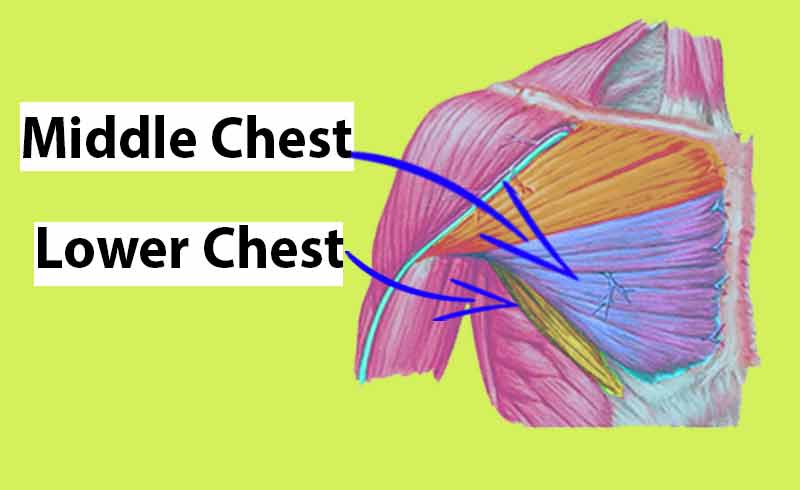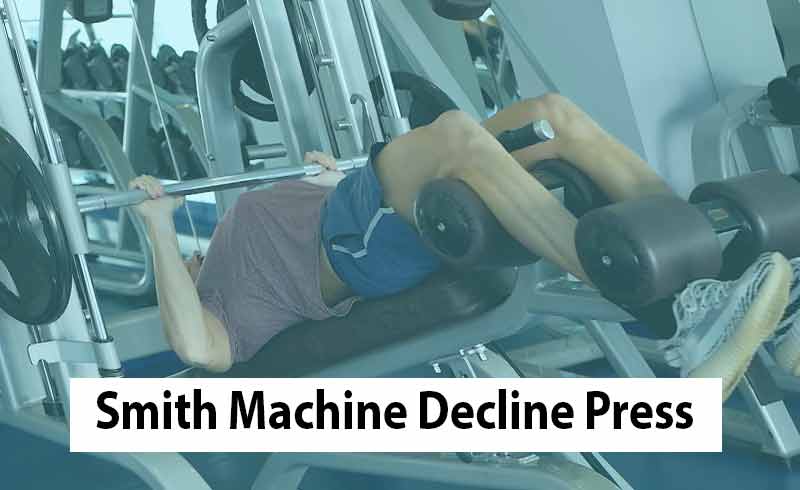In this exercise guide, we’ll be discussing how to do Smith Machine Decline Bench Press. This workout strengthens your upper body by working the triceps and the lower half of the chest.
Before we begin, ensure you have access to a Smith Machine and a decline bench in your local gym.
Exercise Details:
| Specs | Details |
|---|---|
| Also Called | Smith Machine Decline Press |
| Exercise Type | Weightlifting, Strength |
| Difficulty Level | Beginner |
| Body Part | Upper Body |
| Main Targets | Lower chest (Pectoralis major), Front delts (Shoulders) |
| Secondary Targets | Triceps, Upper back |
| Compound/Isolated | Compound |
| Force Type | Push |
| Equipment Required | Smith Machine, Decline Bench, Barbell |
| Rest Time | 1-2 minutes between sets |
What is a Smith Machine Decline Press?
The Decline Smith Machine Bench Press is a specific exercise variation that builds on the traditional decline bench press and is aimed at targeting the chest muscles.
In a regular decline bench press, the lifter uses a free-weight barbell while lying on a decline bench with its head positioned lower than its feet.
This exercise demands a certain level of shoulder stability to control the weight and movement of the barbell.
The Decline Smith Machine Press Benefits:
- Better Lower Back Condition: Unlike the flat bench press where people often arch their backs excessively, the decline Smith machine press allows for a smaller arch, which is better for your spine when lifting heavy weights.
- Lessened Shoulder Pressure: The Smith machine decline bench press focuses on the chest muscles and reduces strain on the shoulders compared to the flat bench press, which can sometimes cause shoulder discomfort.
The decline bench press allows you to lift more weight safely compared to other bench press variations:
The angle and positioning of the decline bench engage larger pectoral muscle fibers, leading to muscle stimulation and growth over time.
However, it’s essential to note that as you progressively increase the weight, you should always have a Training Partner, Personal Trainer, or Spotter present for safety and to prevent serious injuries.- Safer Lifting Technique: In the decline Smith machine press, you don’t need to reach behind your head to unrack the barbell, making it safer and more practical, especially when lifting heavy weights without a spotter.
- Enhanced Lower Chest Development: The decline press is great for developing the lower chest muscles, which is essential for achieving a well-rounded and muscular chest. Research shows it activates a significant amount of lower chest muscle fibers.
DeclineSmith Machine Bench Press Muscles Worked
Performing the decline bench press on a Smith machine primarily targets the following muscle groups:

1. Chest
The decline bench press on a Smith machine is highly effective for engaging the lower pectoral muscles.
By adjusting the angle of the bench, you can place more emphasis on the lower part of your chest.
This exercise helps in achieving a well-defined and sculpted lower chest, contributing to a more chiseled appearance.
2. Triceps
While the primary focus is on the chest, the decline bench press also engages the triceps as secondary muscles.
As you push the barbell upward, your triceps come into action to assist in the pressing movement. Adjusting your grip on the bar can influence the level of tension on the triceps versus the chest.
3. Front Delts
Compared to a flat Smith machine bench press, the decline bench press places less stress on the front deltoids (front shoulder muscles).
This is because the chest is in a mechanically advantageous position to perform the pushing motion, allowing the chest to take the lead in the exercise.
As a result, the front delts are not as actively involved during the decline bench press as they would be during a flat press.
How to Do a Smith Machine Decline Bench Press for Stronger Lower Chest and Triceps
Step 1: Setting Up the Equipment
Positioning the Bench:
Start by placing the decline bench in the middle of the Smith Machine’s barbell.
It’s crucial to center the bench to maintain balance and stability during the exercise.
Checking Barbell Alignment:
To target the lower part of your chest effectively, verify that the barbell is at the right height. Do this with an unloaded barbell to make it easier.
Stand facing the bench and lower the barbell towards your chest. Ensure it aligns with the lower part of your chest, neither too high nor too low.
Proper Bench Position:
Sit on the decline bench and secure your legs using the provided supports with your feet shoulder-width apart.
To optimize your form during the exercise, arch your back, keep your chest up, and hold your head in a neutral position.
Step 2: Doing the Smith Machine Decline Bench Press
Loading the Machine:
Now that the bench is in position, it’s time to load up the Smith Machine with the desired weight.
Getting into Position:
Sit on the decline bench and ensure that your legs are secured between the supports for stability.
Grab the barbell with an overhand grip (palms facing away from you) at a shoulder-width distance apart.
Proper Form:
Arch your back slightly and keep your chest lifted throughout the movement. This helps engage your chest and triceps more effectively.
Also, make sure your elbows are close to your body to minimize strain on your shoulders.
Unlocking the Smith Machine:
Rotate your hands outwards to unlock the Smith Machine. This is an essential safety feature of the equipment.
Performing the Press:
Maintaining a tucked-in elbow position, lower the barbell towards your lower chest. Aim to bring the barbell just above your chest without bouncing it off your body.
Locking the Smith Machine:
Rotate your hands back inwards to lock the Smith Machine, ensuring stability and safety during the exercise.
Repeating the Reps:
Safely repeat the exercise for the desired number of reps and sets, focusing on maintaining proper form throughout.
Mistakes to avoid when performing the decline Smith machine press:
1. Excessive Decline:
Avoid setting the Smith machine bench at an excessively steep decline angle.
While it may allow you to lift heavier weights, it shortens the range of motion (ROM) and puts extra stress on your joints without providing additional chest stimulation.
2. Heavy Lifts:
The declined Smith machine press is not meant for testing one-rep maxes. It’s designed to target the lower chest and build muscle, not for powerlifting purposes.
Trying to lift the maximum weight on this exercise can lead to shoulder issues and an increased risk of injury.
Stick to a moderate weight range and focus on proper form and muscle engagement.
3. Limited Range of Motion
The lack of a full range of motion during weight training can be problematic when dealing with increased weight.
This limitation can cause tension in the pectoral muscles and increase the risk of injury while also negatively affecting daily functionality and the health of surrounding joints.
To counter this, it’s essential to select an appropriate weight that allows you to complete the entire concentric/eccentric movement.
4. Incorrect Breathing Technique
Implementing the correct breathing technique, which involves inhaling during the eccentric phase and exhaling during the concentric phase, can significantly improve exercise efficiency.
This approach also enables you to exert greater effort during different movements and synchronizes well with the exercise tempo.
By incorporating these adjustments, you can enhance your weight training results and overall workout performance.
5. Improper Decline Bench:
Always use a proper decline bench with leg supports when performing the decline Smith machine press.
Using a generic weight bench without leg supports can be dangerous, especially when combined with an excessively steep decline angle.
Leg supports are crucial for stabilizing your body during exercise and ensuring your safety.
Using a fixed decline bench with leg supports is essential as it helps prevent injuries and provides a stable base for your movements.
If your gym does not have an adjustable decline bench with leg supports, consider using free weights or other chest exercises instead.
6 Smith Machine Decline Bench Press Alternatives
Here are some different exercises you can try instead of the Decline Smith machine press:
1. Flat Smith Machine Bench Press
If your gym doesn’t have an adjustable decline bench, you can do the flat Smith machine bench press instead.
It’s easy to set up and safe, which is good if you prefer to work out alone.
2. Smith Machine Incline Press
If you want to focus on your upper chest, the Smith machine incline press is a great alternative to the decline bench press.
It’s a really effective exercise that can help you build strong chest muscles.
3. Decline Dumbbell Bench Press
A variation of the bench press using dumbbells on a decline bench, targeting the lower and inner chest muscles.
4. High to Low Cable Fly
This exercise is performed on a cable machine with handles starting high and moving towards the lower body, engaging the same muscles as the decline bench press.
5. Incline Push-Ups
It is a push-up variation done with hands on an elevated surface to emphasize the lower chest muscles.
6. Smith Machine Close Grip Bench Press
If you want bigger arms and chest, try the Smith machine close grip bench press. It’s a good choice because it works your triceps along with your chest muscles.
Some people even do dumbbell curls right after to save time and get a better pump in both muscles.
These exercises can give you a variety of ways to work your chest muscles using the Smith machine.
Conclusion:
You have now mastered the correct technique for the Smith Machine Decline Bench Press. This compound exercise targets your lower chest and triceps, promoting overall upper-body strength.
References & Sources:
- Schick EE, Coburn JW, Brown LE, Judelson DA, Khamoui AV, Tran TT, Uribe BP. A comparison of muscle activation between a Smith machine and free weight bench press. J Strength Cond Res. 2010 Mar;24(3):779-84. doi: 10.1519/JSC.0b013e3181cc2237. Erratum in: J Strength Cond Res. 2011 Jan;25(1):286. PMID: 20093960.
- https://www.thesilverlining.com/safety-tips/safe-spotting-for-weight-training
- Melani A, Gobbi G, Galli D, Carubbi C, Masselli E, Neri LM, Giovinco G, Cicchella A, Galuppo L, Presta V, Vaccarezza M, Vitale M, Mirandola P. Muscle Activation in Traditional and Experimental Barbell Bench Press Exercise: A Potential New Tool for Fitness Maintenance. Sports (Basel). 2019 Oct 17;7(10):224. doi: 10.3390/sports7100224. PMID: 31627293; PMCID: PMC6835758.
- Bench Press Calculator - April 22, 2024
- Press to Handstand: Ultimate Step-by-Step Guide - April 22, 2024
- Cable Press (How To Do, Benefits, Targeted Muscles, Alternative) - April 22, 2024

